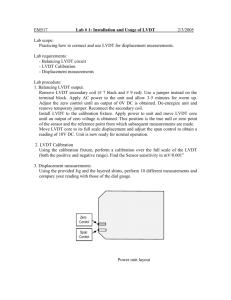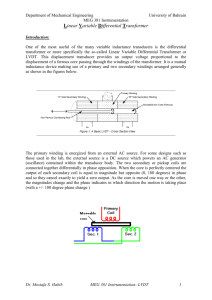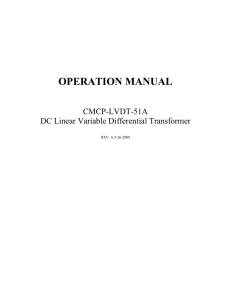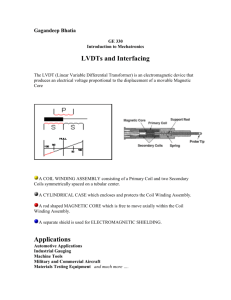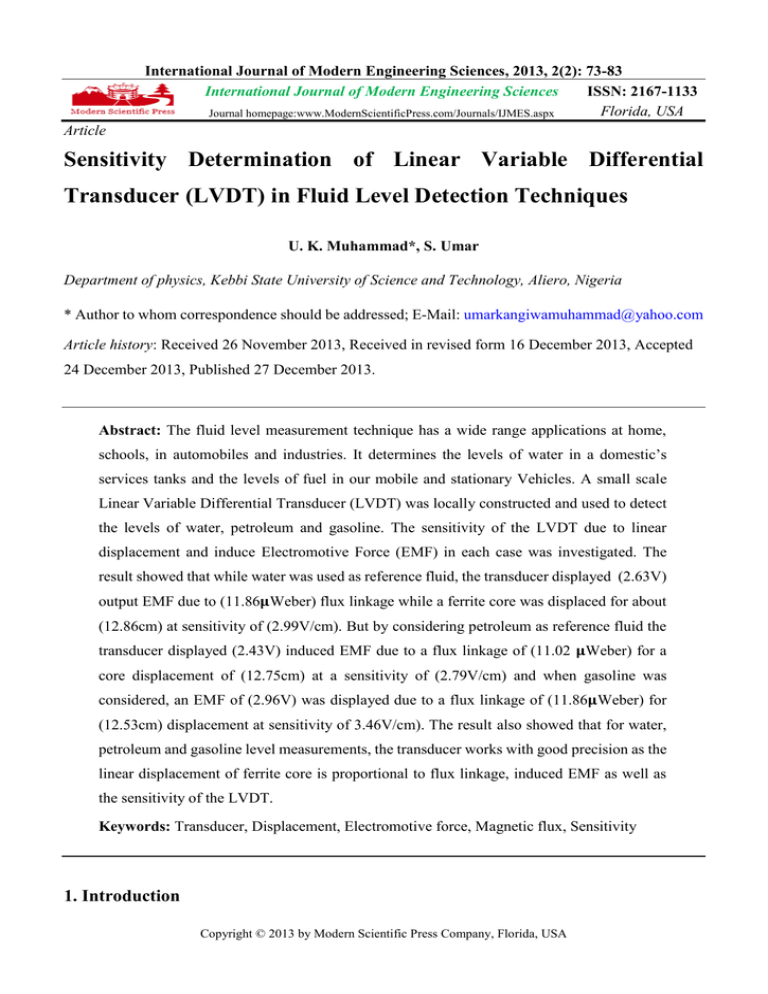
International Journal of Modern Engineering Sciences, 2013, 2(2): 73-83
International Journal of Modern Engineering Sciences
ISSN: 2167-1133
Florida, USA
Journal homepage:www.ModernScientificPress.com/Journals/IJMES.aspx
Article
Sensitivity Determination of Linear Variable Differential
Transducer (LVDT) in Fluid Level Detection Techniques
U. K. Muhammad*, S. Umar
Department of physics, Kebbi State University of Science and Technology, Aliero, Nigeria
* Author to whom correspondence should be addressed; E-Mail: umarkangiwamuhammad@yahoo.com
Article history: Received 26 November 2013, Received in revised form 16 December 2013, Accepted
24 December 2013, Published 27 December 2013.
Abstract: The fluid level measurement technique has a wide range applications at home,
schools, in automobiles and industries. It determines the levels of water in a domestic’s
services tanks and the levels of fuel in our mobile and stationary Vehicles. A small scale
Linear Variable Differential Transducer (LVDT) was locally constructed and used to detect
the levels of water, petroleum and gasoline. The sensitivity of the LVDT due to linear
displacement and induce Electromotive Force (EMF) in each case was investigated. The
result showed that while water was used as reference fluid, the transducer displayed (2.63V)
output EMF due to (11.86𝛍Weber) flux linkage while a ferrite core was displaced for about
(12.86cm) at sensitivity of (2.99V/cm). But by considering petroleum as reference fluid the
transducer displayed (2.43V) induced EMF due to a flux linkage of (11.02 𝛍Weber) for a
core displacement of (12.75cm) at a sensitivity of (2.79V/cm) and when gasoline was
considered, an EMF of (2.96V) was displayed due to a flux linkage of (11.86𝛍Weber) for
(12.53cm) displacement at sensitivity of 3.46V/cm). The result also showed that for water,
petroleum and gasoline level measurements, the transducer works with good precision as the
linear displacement of ferrite core is proportional to flux linkage, induced EMF as well as
the sensitivity of the LVDT.
Keywords: Transducer, Displacement, Electromotive force, Magnetic flux, Sensitivity
1. Introduction
Copyright © 2013 by Modern Scientific Press Company, Florida, USA
Int. J. Modern Eng. Sci. 2013, 2(2): 73-83
74
Transducer is defined as an electronic device that used to convert one form of energy into another.
Instrument transducers used for measuring physical quantities by electrical means are referred to as
sensors or detector. The term transducers are supplied to any device which converts a mechanical or
other measurable phenomenon in to electrical ones or vice versa. Example, in electrical generator,
mechanical energy is converted to electrical energy, in electrical motor, electrical energy is converted to
mechanical energy. Moreover, in microphone, mechanical energy is transform in to electrical signal, in
loudspeaker, electrical signal is transform in to mechanical energy, in solar panels, and solar radiation is
transform in to electrical energy, in computer, handset and calculator keyboard, mechanical energy is
transform in to electrical signal etc.
Transducers are categorized in to input and output transducers, according to Ulaby F.T (2004),
Edward Arnold (1990) categorized transducers in to passive and active transducers. Passive transducer
is the type of transducer that does not require an external power supply to the effect of the conversion of
one form of signals into another such as photovoltaic cells, piezoelectric transducers, thermoelectric, and
electromagnetic transducers. Active transducer is the type of transducers that have a good requirement
to an external power supply to the effect of the conversion one form of energy into another such as
variable resistance, hall effect, optoelectric, and variable reactance. In this case the variable resistance is
divided into photoconductors, strain gauge, and magneto resistive. Optoelectric is categorized into photo
emissive and photo junction. And variable reactance is divided into inductive and capacitive transducer.
However, Ruocco S.R (1987) categorized transducers according to their function as position, light, force
and velocity transducers.
Transducers have a wide range of applications in school, at homes and for industrial activities.
In school we use electrical generators, computers microphone, motors, loudspeaker, thermistor, and solar
cells, resistance thermometer, differential transformer e.tc. as transducers. In industries we use generator,
motors, robots control, thermistor and differential transformer, etc. as transducers. In home we use
electrical generators, lamps, microphone, loud speaker, electric stoves, refrigerators, and electric fans
etc. as transducers.
Linear Variable Deferential Transformer (LVDT) is an inductive, passive and input transducer
that measure linear displacement directly proportional to induce Electromotive Force (EMF). An LVDT
is an electromechanical transducer that produces an electrical output proportional to the displacement of
a separate movable core. A linear variable differential transformer (LVDT) is a type of electromechanical transducer capable of measuring linear displacement with a high degree of accuracy. Such a
system can be used as a force measuring transducer and can be employed to measure spring deformation
in weighing system (Pratiksha, 2006). It works on the principle of mutual induction LVDT illustrated in
figure consist of three symmetrically spaced coils bound out and illustrated bobbin. A magnetic core,
Copyright © 2013 by Modern Scientific Press Company, Florida, USA
Int. J. Modern Eng. Sci. 2013, 2(2): 73-83
75
which moves through the bobbin, provides a path for magnetic flux linkage between coils. The position
of the magnetic core controls the mutual inductance between the primary coils and two secondary coils
(Yañez-Valdez et al., 2012). The LVDT sensor is basically a transformer. It comprises one primary coil,
two secondary coils, symmetrically spaced with respect to the primary one; and a movable core (Lamar,
2010). The coils are wound onto a tubular coil form. This coil assembly is usually the stationary element
of the sensor. The moving element of an LVDT is a separate tubular armature of magnetically permeable
core which is free to move axially within the coil's hollow bore, and mechanically coupled to the object
whose position is being measured. To obtain a position signal from an LVDT, the primary coil must be
driven by an AC power source, and the voltages from the secondary coils must be demodulated. LVDTs
operate on the principle of transformer.
As shown in figure 1, an LVDT consists of a coil assembly and a core. The coil assembly is
typically mounted to a stationary form, while the core is secured to the object whose position is being
measured. The coil assembly consists of three coils of wire wound on the hollow form. A core of
permeable material can slide freely through the center of the form. The inner coil is the primary, which
is excited by an AC source as shown. Magnetic flux produced by the primary is coupled to the two
secondary coils, inducing an AC voltage in each coil. This association of a signal value to a position
occurs through electromagnetic coupling of an AC excitation signal on the primary winding to the core
and back to the secondary windings. The core causes the magnetic field generated by the primary
winding to be coupled to the secondary.
Figure 1: Schematic diagram of LVDT
The basic transformer formula, which states that the voltage is proportional to the number of coil
windings, is the backbone of the LVDT as:
(1)
Copyright © 2013 by Modern Scientific Press Company, Florida, USA
Int. J. Modern Eng. Sci. 2013, 2(2): 73-83
76
Where N is the number of coil windings and V is the voltage
When the iron core slides through the transformer, a certain number of coil windings are affected
by the proximity of the sliding core and thus generate a unique voltage output. The position of the core
determines how tightly the signal of the primary coil is coupled to each of the secondary coils.
Moreover, the LVDT, being a transformer, operates based on electromagnetic induction obey
principles of faraday’s law, which state; induced EMF is proportional to the rate of change of magnetic
flux as:
𝑉=
𝑑𝜑
(2)
𝑑𝑡
Where 𝜑 is a flux linkage and
𝑑𝜑
𝑑𝑡
is the rate of change of flux, from which the primary and secondary
EMF of the transformer is derived as:
𝑉𝑖𝑛 = 4.44𝑁𝐹𝜑
(3)
𝑉𝑜𝑢𝑡 = 4.44𝑁𝐹𝜑
(4)
Where F is the frequency (Hz) and from this, the flux that links the secondary winding of the transducer
which result induced EMF at the output is given as:
𝜑𝑜𝑢𝑡 =
𝑉𝑜𝑢𝑡
(5)
4.44𝑁𝐹
Since the number of coil windings is uniformly distributed along the transformer, the voltage
output is proportional to the iron core displacement when the core slides through the transformer. This
is given as:
(6)
Where D is displacement of the iron core with respect to the transformer, and M is the sensitivity of the
transformer (slope of the displacement-voltage curve).
Sensitivity of the transducer is defined as the ratio of output to input and therefore, it is given by
the following equation as:
Sensitivity (M) =
(𝑉𝑜𝑢𝑡∗ 𝑉𝑖𝑛 )
𝑉𝑒𝑥 ∗ 𝐷
(7)
Where Vout is the output EMF of LVDT, Vin is the input voltage from the main, Vex is the excitation
voltage to LVDT, and D is the displacement of the core.
According to Howard (2003), LVDTs have certain characteristics features and benefits, most of
which derive from its fundamental physical principles of operation or from the materials and techniques
used in its construction. These characteristics are: Friction-Free Operation, Unlimited Mechanical Life,
Separable Coil and Core, Environmentally Robust, Fast Dynamic Response and Absolute Output.
According to Montrose G. (2003) LVDTs are used in a wide variety of applications: These are used to
Copyright © 2013 by Modern Scientific Press Company, Florida, USA
Int. J. Modern Eng. Sci. 2013, 2(2): 73-83
77
measure displacement ranging from fraction millimeter to centimeter. Acting as a secondary transducer,
LVDT can be used as a device to measure force, weight and pressure, etc. Several of the more common
methods of use have been documented in detailed articles. Although the LVDT is a displacement sensor,
many other physical quantities can be sensed by converting displacement to the desired quantity via
thoughtful arrangements. Several examples will be given. Crankshaft Balancer, Automation Assembly
Equipment, Portable Friction Welder, Robotic Cleaner , Borehole Extensometer, Bottle Height
Inspection, Weighing Systems, Deflection of Beams, Strings, or Rings, Thickness Variation of Work
Pieces and Fluid Level detection. The figures 2-4 below show LVDTs functions (a) as a pressure,
thickness and fluid level gauge.
Figure 2: LVDT as pressure measuring device
Figure 3: LVDT as thickness measuring device
Figure 4: LVDT as Fluid Level gauge
(Courtesy of Montrose, 2003)
Fluid level measurement technique is an essential task that has numerous applications in our day
to day activities. The drivers of stationary and mobile vehicles would like to know the gauge of the fuel
in the tanks and at home, we wish to know the gauge of water in our service and toilet reservoirs. This
Copyright © 2013 by Modern Scientific Press Company, Florida, USA
Int. J. Modern Eng. Sci. 2013, 2(2): 73-83
78
enables effective controls over these components without direct contacts so as to avoid the effects of fuel
shortage and over flow of water when reservoirs got full. It is therefore, requires some electrical and
electronics components
for effective controllability and suitable operations. LVDT is an electrical
device that converts of linear displacements of fluid into electricity and sense the electronic sensors to
detect the gauge of the fluid. However, in this research a conventional LVDT was constructed and used
up to measure the level of petrol, gasoil, and water. Its sensitivity, due to induced EMF and displacement
was investigated.
2. Materials and Methods
The LVDT which is the basic electrical system for this research comprised a 220V/ 15VAC,
50HZ step down transformer, a transducer coils a ferrite core, a floating object (plastic ball) and a sensor
(multimeter). The LVDT has been locally constructed using components that are available in our road
side shops. A transducer primary coil was made by winding 1000 turns of an enamel copper wire on a
non magnetic cylindrical air core (aluminium core). Two, 500 turns was made in series on the insulated
primary coil to form a secondary coil of the transducer. The input of the step down transformer was
connected to the AC mains, while its output to the transducer primary coil through a switch. The output
of the transducer (primary coil) was connected to the (DT9205A) multimeter. The ferrite core was
joining to the plastic ball and placed in a plastic calibrated bucket such that it can pass the transducer
core when it has been displaced by a fluid poured in the bucket. The figure 5 shows the schematic
diagram of the constructed system.
The step down transformer been connected to the AC mains, steps down the 220V, 50HZ AC
to 15VAC. As the switch is on, the 15VAC would pass to the primary coil of the transducer, and excited
it. The primary coil would generate flux and distributed it into the air gap but no EMF at the output.
When fluid was poured into the bucket through the funnel, the plastic ball floats on the fluid and rose up
causing the ferrite core to be displaced in the air gap. The ferrite core had been a magnetic material,
when being displaced in the air gap caused flux to be changing and resulted induces EMF at the output
through the multimeter. Due to fact that water, petrol and gasoil have different densities of 1,000kgm-3,
881kgm-3 and 835kgm-3 respectively, they were all used up as a fluid in this work and determined the
sensitivity of this constructed LVDT. The figure 6 captured the picture of LVDT system under operation.
Copyright © 2013 by Modern Scientific Press Company, Florida, USA
Int. J. Modern Eng. Sci. 2013, 2(2): 73-83
Figure 5: Schematic diagram of the constructed LVDT system
Figure 6: Picture of LVDT system
Copyright © 2013 by Modern Scientific Press Company, Florida, USA
79
Int. J. Modern Eng. Sci. 2013, 2(2): 73-83
80
The displacement (D) of ferrite core through the air gap due to increase of fluid level in the
container and the respective EMF (𝑉𝑜𝑢𝑡 ) would be recorded as the fluid is being poured in to the container
through the funnel. The flux (𝜑𝑜𝑢𝑡 ) that caused the induce EMF would be evaluated by using the EMF
induced, number of turns of secondary coil of LVDT and AC frequency in equation (5). The sensitivity
(M) of the transducer in each case would be evaluated by using the values of displacement and induce
EMF in equation (7). Three experiments were conducted for each of three fluid, averages were taken
and recorded in tables (1.0), (2.0) and (3.0). The results were analyzed by using a Microsoft Excel. The
graphs of averages displacement and fluid levels against flux linkage, induced EMF and Sensitivity are
being plotted for analysis.
3. Results and Discussions
Despite the fact that, the total density of the plastic ball and ferrite core been attached to it is less
than the density of the fluids, they floated on the fluid surface and the ferrite core displaced linearly
through the LVDT coils. As the coils were excited by the output of the step down transformer, flux is
produced and linked the secondary coils. When the level of fluid (Litre) is increased, the ferrite core has
further displaced in the coils, it changed the flux linkage and the EMF generated is detected through the
multimeter. With water as a reference, the result shows that when water being poured in to the tank
reached 3.5litre, the core displacement was at 12.36cm which induced EMF of 2.63V due change in
11.86𝛍Weber flux linkage at a Sensitivity of 2.99V/cm. these were shown in figure 7. It has also shown
14
3.5
12
3
10
2.5
8
2
6
1.5
4
1
2
0.5
0
0
0.5
1.4
1.7
2
2.3
2.5
2.8
3.2
Output EMF (Volts)
Displacement (cm)
that the flux linkage and EMF are proportional to displacement.
Displacement (cm)
Magnetic Flux
linkage (𝛍Weber)
Induce EMF (Volts)
Sensitivity (V/cm)
3.5
Water level (Litre)
Figure 7: Graph of LVDT performance using water as reference fluid
The figure 8 is a result analysis of LVDT test by using petroleum as a reference fluid. The result
shows that when 3.5litre of petroleum was poured into the tank, the ferrite core was displaced for about
Copyright © 2013 by Modern Scientific Press Company, Florida, USA
Int. J. Modern Eng. Sci. 2013, 2(2): 73-83
81
12.75cm through the coil which changed the flux linkage of 11.02𝛍Weber and induced an EMF of 2.43V
at a Sensitivity of 2.97V/cm. However, the flux linkage, the EMF generated and sensitivity are
14
3
12
2.5
10
2
8
1.5
6
1
4
2
0.5
0
0
0.5
1.3
1.6
1.93 2.23
2.5
2.7
3
Output EMF (volts)
Displacement (cm)
proportional to displacement.
Displacement (cm)
Magnetic Flux linkage
(𝛍Weber)
Induce EMF (Volts)
Sensitivity (V/cm)
3.5
Petroleum Level (Litre)
Figure 8: Graph of LVDT performance using petroleum as a reference fluid
The figure 9 is an analysis of LVDT performance by using gasoline as a reference fluid. The
result shows that when 3.5 litre of gasoil was poured into the tank, the ferrite core was displaced for
about 12.53cm through the coil which changed the flux linkage of 11.86𝛍Weber and induced an EMF
of 2.96V at a Sensitivity of 3.46V/cm. However, the flux linkage, the EMF generated and sensitivity are
14
4
12
3.5
3
10
2.5
8
2
6
1.5
4
1
2
0.5
0
Output Emf (volts)
Displacement (cm)
proportional to displacement.
Displacement (cm)
Magnetic Flux linkage
(𝛍Weber)
Induce EMF (Volts)
Sensitivity (M)
0
0.5 1.16 1.5
1.8 2.23 2.46 2.73 3.2
3.5
Gasoline Level (Litre)
Figure 9: Analysis of LVDT performance by using gasoline as a reference fluid
Copyright © 2013 by Modern Scientific Press Company, Florida, USA
Int. J. Modern Eng. Sci. 2013, 2(2): 73-83
82
However, when the maximum displacements, EMFs and the maximum capacity of the tank of
this conventional LVDT were considered as parameters for functional sensitivity in (V/cm) and (V/litre),
the meter displayed (0.205V, 0.191V and 0.236V) for water, petrol and gasoil respectively, when a
magnetic core was displaced linearly for 1cm through the air gap. So also, it displayed (0.75V, 0.69V
and 0.85V) for water, petrol and gasoil respectively when the fluid level in a tank reached about 1litre.
Moreover, the theoretical maximum output EMF of this conventional LVDT is 7.5V by virtue of its
windings. But due to the fact that the EMF output of a transducer has also depends on the relative
permeability of the magnetic (ferrite) core and the air gap, a ferrite core of 750 relative permeability and
1.2cm2 cross- sectional area, when been displaced in an air gap of 2.2cm2 cross- sectional area induced
maximum EMFs of (2.63V, 2.43V and 2.96V) for water, petrol and gasoil respectively. Despite these
results, the conventional LVDT was (35.06%, 32.4% and 39.5%) efficient for water, petrol and gasoil
level detection technique respectively.
4. Conclusion
The application of electrical, electronics and control engineering in physics advanced the use
transducers for measuring and detecting the level of fluid in our domestic water tanks (reservoirs) and
our mobile and stationary vehicles fuel tanks. This enables us to know the level and amount of fluid in
our tanks without direct contact, so as to switch off the pump supplying the fluid when it’s full tank.
Although this LVDT is conventional, but it could be improved and integrate with electronic control
device and this provides a means of automatic control if connected to the switch of the water or fuel
pump. Conclusively, an automatic LVDT was found in motor cars fuel pump, in fuel filling stations, in
building constructions and industrial robot controls.
References
[1]
Edward, A., Principles of Electronics Instrumentation, Chapman and Hall, HC. New York, 1990,
pp.183-191
[2]
Greg, M., American Sensor and Technology, LVDT Technology Elevates Differential Pressure
Transducer, 2003, (Online) at www.LVDTtechnology.com, 20/3/2013, 02:11pm
[3]
Howard, S., A., Micro sensors, LVDT Basis, Innovation in a Sensing Position, USA, 2003,
(Online) at www.macrosensors.com, 23/5/2013, 02:07pm
[4]
Lamar, H., Fluid level gauge, University of London, 2010, (Online) at www.hydac.com 18/4/2013,
1:21pm.
[5]
Pratiksha S., and Bordoloi, P., K., Design of LVDT Based Digital Weighing System, International
Journal of Electronics and Computer Science Engineering, 1(4)(2006): 2100-2106.
Copyright © 2013 by Modern Scientific Press Company, Florida, USA
Int. J. Modern Eng. Sci. 2013, 2(2): 73-83
83
[6]
Ruocco, S., R., Robot sensor and transducers, John Willy and sons New York, 1987, pp.26-33
[7]
Ulaby, F., T., Fundamentals of Applied Electromagnetic, Pearson Prentice Hall, New Jersey, 2004,
(Online) at www.wikpedia.org/wik/transducer 15/03/2013. 12:47pn
[8]
Yanez Valdez, R., Gallegos, R., Caballero, A., Ruiz, L., Selection of Soft Magnetic Core Materials
Used on an LVDT Prototype, Journal of Applied Research and Technology, (2012): 195-205.
Copyright © 2013 by Modern Scientific Press Company, Florida, USA

